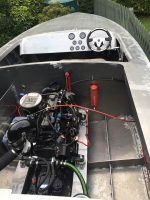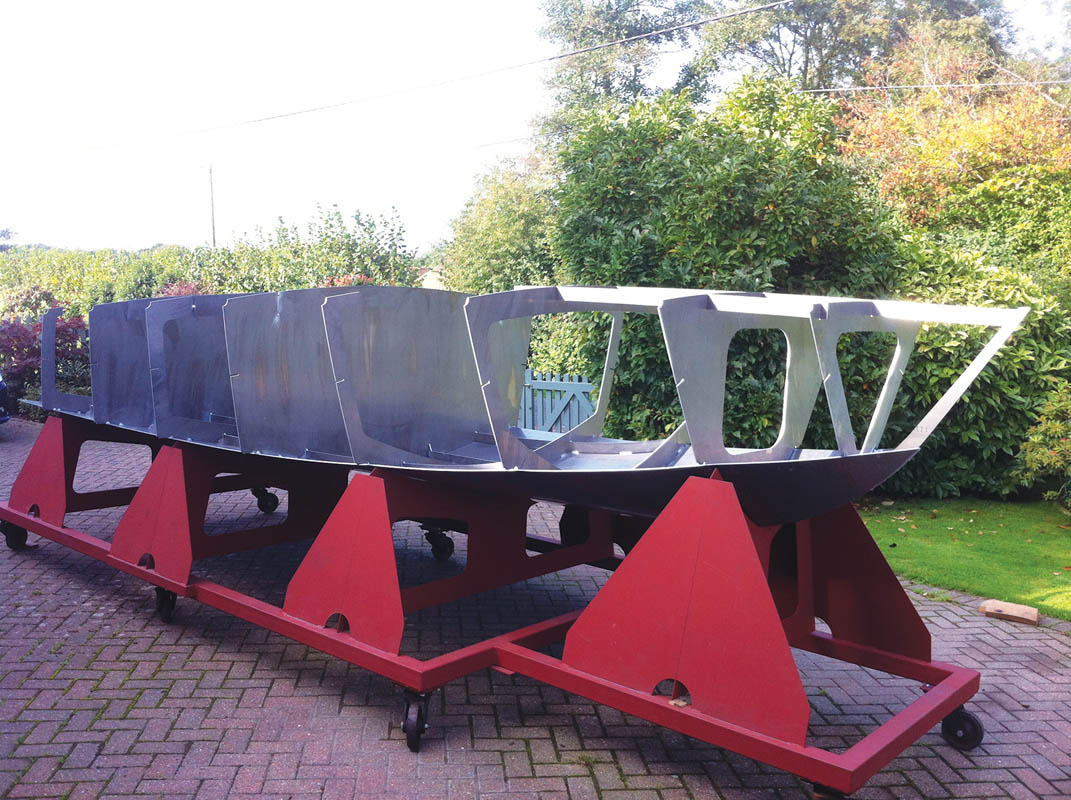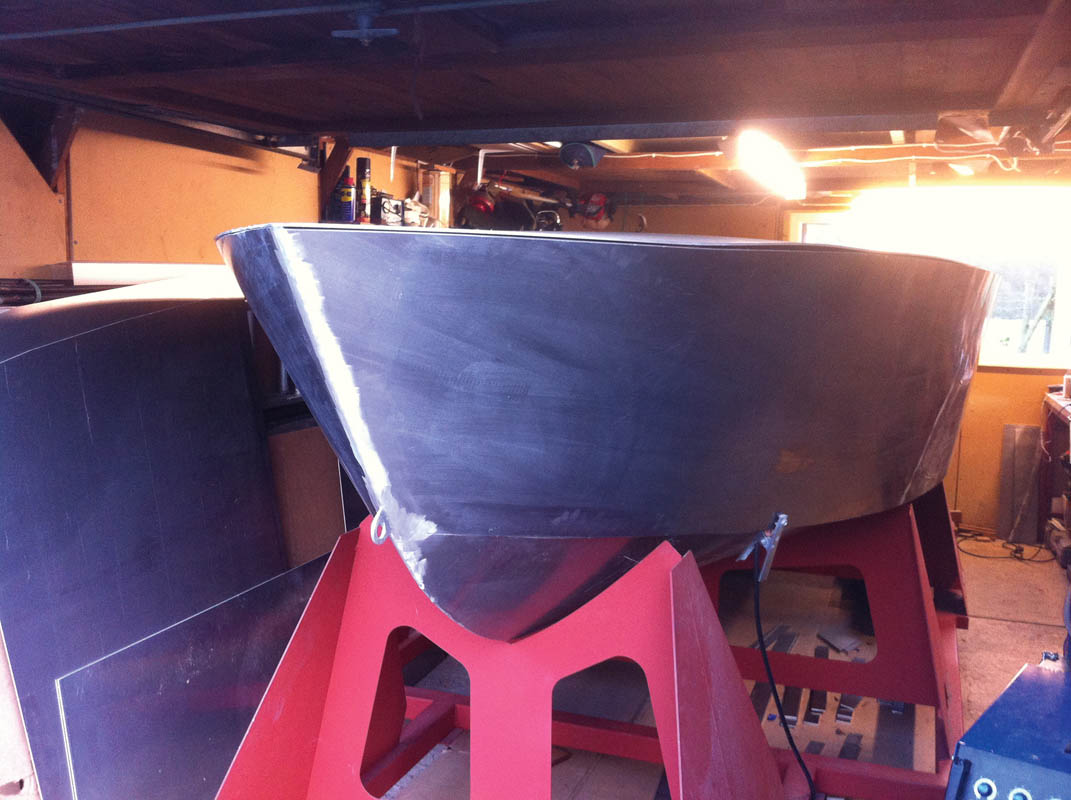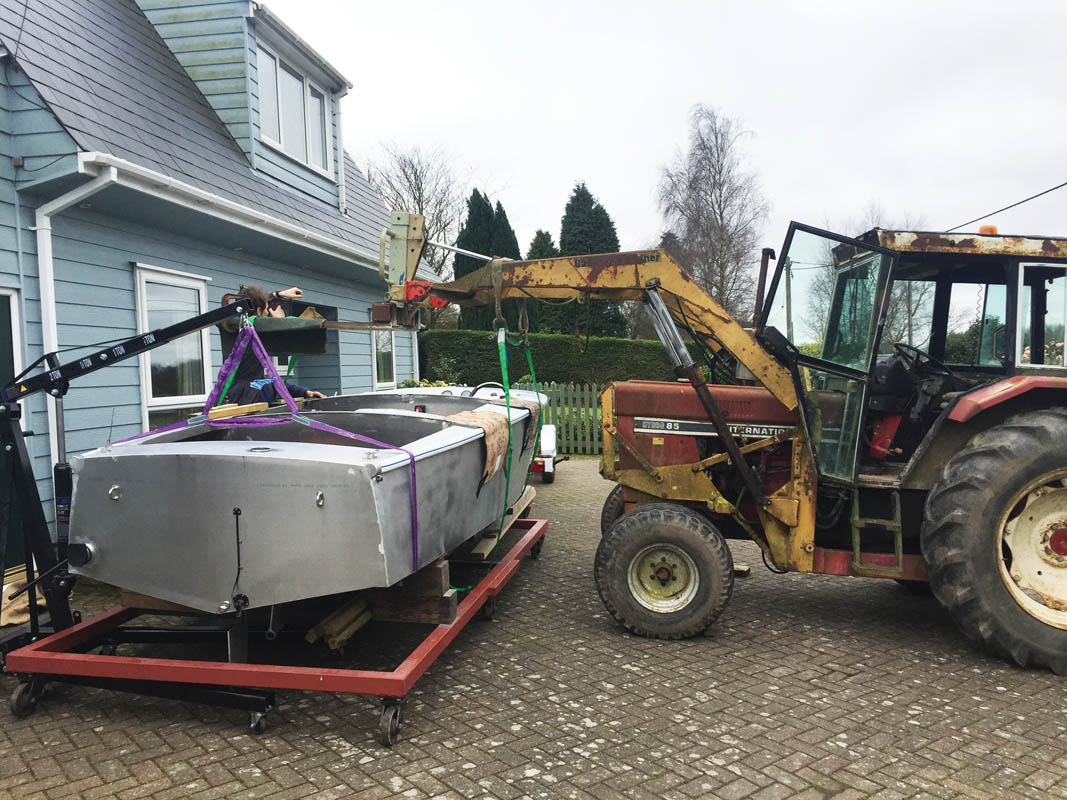When James Oakley received some devastating health news, he became more determined than ever to complete his home-built bespoke aluminium powerboat. Mike Taylor finds out more...
Late in 2015, just as James Oakley was finishing the hull of his home-built aluminium speedboat, he was diagnosed with prostate cancer.
“I’d been to see my doctor for something minor when the nurse advised me to have a blood test,” he recalls. “This indicated an abnormally high reading of PSA and I was recommended to have a biopsy.”
James was advised there was a tiny chance of infection, but what he didn’t anticipate was being woken three nights in a row, delirious with acute sepsis. After specialist treatment in a local hospital to deal with the infection, he chose to have surgery, but doctors warned he might not make it to Christmas.
“While it was devastating news I just wanted to have the operation as soon as possible so I could continue working on the boat,” says James. “The situation was extreme, but I just wanted to get to continue on with my plans.’
Fortunately, the operation was a success and James began the period of recuperation, which caused him to look at life differently.
“The boat gave me a focus; something to concentrate my life on, away from brooding about my health scare. It made me decide to take on the risk of finishing the boat, with the view to setting up a business.”
Until this point, James’s project had been more of a hobby, borne from a childhood love of boating. Born in Harpenden, Hertfordshire in 1956, James experienced his first taste of boating at the age of four.
“Our first family speedboat was a second-hand plywood-built Cresta of the 1960s. It had a reputation for having a weak hull so a joiner friend of my father’s strengthened it and we put a new 50hp Mercury outboard on the back,” he recalls. “We did a lot of water skiing at Cosgrove Lake and on the River Blackwater in Essex. We also took it with us to Brittany on holidays.”
James’s father replaced the Cresta with an Avon RIB, which the family took abroad, and later, a 17ft Broom Pisces, which they often trailered to Menorca .
As an adult, James still hankered after a boating life, and when the children came along, bought a 19ft Corribee sloop. After a move to the Hamble and a change of career from working in the family textile business to becoming involved with gas turbines, he was able to purchase a Sealine 19, and later a larger Princess 286 Riviera, which he nearly lost on passage to the Channel Islands.
“We were motoring at around 25 knots when I spotted a dark shadow in the water! It turned out to be a partially submerged sea container. That was a close call,” he says grimly.
In 2013, two years before his life-changing diagnosis, James decided to learn how to build a boat from scratch. But what was it that gave him the notion for such an ambitious project?
“I’ve always derived great satisfaction from solving challenges and inventing things,” he says. “One project, in particular, was a gas turbine engine that generated renewable electricity using the gas flared off at old landfill sites.”
After this, James’s thoughts moved to building his own speedboat. He considered GRP, but there are several stages, from making a plug to producing the mould, and the whole process is very expensive just for one boat.
An aluminium hull, on the other hand, wouldn’t require a mould.
With the advent of laser cutting techniques James spent several months searching the Internet for someone who had knowledge of designing aluminium speedboats.
“Most marine architects wanted serious money for creating the kind of boat I had in mind,” he says.
“Eventually, in March 2013 I found Hal Whiteacre in America who, among other things, designs yachts and powercraft, including boats for the Great Lakes, where the wind can blow up and it becomes quite choppy.”
James and Hal swapped illustrations of the kind of boat James had in mind and in April he commissioned Hal to design a 19ft mid-engined classic style speedboat with seats fore and aft ‘at a sensible price’.
Working to an agreed timetable it took until September for Hal to complete the designs. During this time, James reviewed whether he could turn his amateur project into a professional business model. He took a course at the British Marine Federation to ensure the design complied with RCD regulations in order to be CE certified. Critically, as part of the commission with Hal, he requested a set of digital cutting files, which gave him the opportunity to have either one or many sheets cut to size if he decided to go into limited series production.
James arranged for the files to be used with a laser-cutting machine at a company in East Sussex, which specialises in this type of work.
“Having pre-cut alloy panels makes the assembly process essentially self-jigging – the boat taking on the desired shape simply by attaching each section as each panel is welded together,” says James.
“They never got to see the actual plans for the boat so didn’t know what the myriad of aluminium pieces would be used for.”
The majority of the assembly work would be undertaken in James’s large workshop. To accommodate the hull as it was assembled in December 2013 he began building a steel frame with upright supports to act as a cradle.
“When I collected the aluminium panels from the laser specialist, it was almost like a flat-pack boat kit with each part identified by its own engraved reference number, which I could cross-reference with Hal’s plans.”
To gain experience of using Metal Inert Gas (MIG) welding, a process developed in the 1940s for welding aluminium and other non-ferrous metals, James bought the plans for a small 8ft (2.5m) dinghy and taught himself how to build it.
“It was essential to gain that knowledge first before I started on the main project,” he says.
He became friendly with an aluminium boat builder in Newhaven who showed him a lot of the techniques involved with building boats.
“In the end I built two small dinghies, but the market is so cut-throat and price sensitive in this sector that there was no opportunity to develop this as a sideline to the core business of the 19ft speedboat.”
The build begins
In April 2014 James began work on the speedboat by welding the two bottom hull plates together, which sat on the build cradle. Working from bow to stern he tack-welded the eight bulkhead and frame sections into position along with the stringers. Then the side panels and transom were fitted and again these were just tacked in place, initially to allow things to be realigned later, if required.
Once this was done the two deck sections (there is a join in the centre running across the deck) were also tacked into place, the entire boat being assembled right way up.
“Most of the time this was done on my own, occasionally helped by my wife Annie, who held pieces in position while I tack welded them,” he explains. “The only thing that fazed me was the process of manipulating the larger panels such as the hull side plates. For this process I used ratchet straps and G-clamps to pull them into the curves as the panels followed the shape of the frames and bulkheads.”
Recalling the whole build programme, one hurdle which James did have to deal with was welding in confined spaces.
“When I attached the deck panels this involved lying on my back inside the hull and welding above me. I arranged for a fan to deal with the toxic welding fumes, but it was quite uncomfortable.”
Complete hull
In the autumn of 2015, 18 months after starting assembly, the structure took on the shape of a sleek speedboat. However, James was forced to put the project on hold whilst he recovered from cancer, and it wasn’t until April 2016 that he felt well enough to continue.
“Initially, the whole experience had wiped me out. But I no longer had my day job and I thought that with a concerted effort I could finish the boat quickly and put the whole programme on a commercial footing. How wrong I was about that! Naively, I had completely misread the amount of work and cost involved in putting the programme onto a commercial platform.”
James sought quotes for painting the hull, which he found to be “considerable”, but he wanted a high-end look: “I decided the boat had to encompass elegance and style, and so this dictated the remainder of the build.”
Finally, he found a world leading powerboat painter who was semi-retired and happy to take on the fairing and painting. In keeping with the hull, James needed quality fittings such as stainless steel deck attachments, a mahogany dashboard and rubbing strake, and the faux-leather seating trim.
Final touches
Part of the fitting out programme involved making a moulded acrylic windscreen. This encompassed creating a male former with the gradual curvature needed to mirror the lines of the deck. To do this, the original pattern was created on the boat using cardboard templates. The former was then taken to a company who hot-moulded the acrylic screen onto it.
 By now the craft had been christened Shearwater 19 and her classic styling dictated the need for a mid-mounted power unit. Originally, James thought of fitting a 3-litre Nanni diesel engine, but research revealed it was unsuitable because of its characteristics and weight. He then decided on the 3-litre 135hp Mercruiser petrol engine, adapted to drive through a conventional marine gearbox that was more suited to this type of boat.
By now the craft had been christened Shearwater 19 and her classic styling dictated the need for a mid-mounted power unit. Originally, James thought of fitting a 3-litre Nanni diesel engine, but research revealed it was unsuitable because of its characteristics and weight. He then decided on the 3-litre 135hp Mercruiser petrol engine, adapted to drive through a conventional marine gearbox that was more suited to this type of boat.
When the boat was water-ready, but before the finishing touches were done, James took it to Weir Wood Lake in East Sussex for testing.
“There was nothing fundamentally wrong, though there was a vibration caused through a drive plate in the bell housing which had been incorrectly machined,” says James.
Consequently, the drive train was stripped down and a replacement drive plate installed. On the third visit to the lake A company who specialize in RCD testing and certification, came along and went through extensive trials to ensure the boat complied with RCD regulations, including exhaust noise testing. Thankfully the Shearwater 19 passed and was certified.
James took her to a lake in Chichester where, with special dispensation, maximum speed runs and drone photography were carried out.
“After all the hard work and my health scare it was very exhilarating to see her finally finished and performing as she should. It gave me a real feeling of accomplishment.”
With hindsight, James questions whether a Shearwater’s classic design was the right choice:
“It was the wrong move,” he admits.
“I should have thought more commercially and designed a typical boat for today’s market with a bluff prow and open decks, though that would not have suited my personal taste.”
But he remains philosophical. “Shearwater was there for me, steering me through a very emotionally challenging and turbulent period in my life. Overall, the project has cost me a lot of money. Now, sadly, she is up for sale, and I have a new job back in renewable energy. Life moves on.”
















